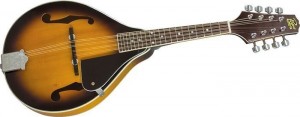The mandolin is a pretty cool instrument. Since it has a neck, a rounded back, and has strings that can be either strummed or plucked it is classified as a member of the lute family. The top of the mandolin, called the soundboard since it is here where the sound is primarily created, comes an many different shapes that is mostly round or a teardrop. They can either have scrolls or other things coming off of it. There can be a whole host of different shapes of the hole or holes that are also on the top underneath the strings.
One thing that makes this such a cool instrument is the fact that they are generally smaller than most guitars and therefore can be easier to play for children and people with smaller hands. Now since it is smaller than most guitars, the sound that is created is generally of a higher pitch than a guitar sound. This makes the sound a bit more twangy than many guitars and is used quite frequently today in bluegrass music. However, as music has progressed over the years, this instrument has made its way into rock and roll and blues music as well.

Many people think the mandolin to be the easiest of all instruments to learn to play. This is because you will find only four courses of strings, you have frets as note markers (much simpler than learning violin for example), most of the open-position chords only require two fingers, you only having to play with a flatpick (as opposed to fingerpicking for example on the banjo or the dobro), the smaller neck doesn’t need the stretch that longer neck instruments such as guitars demand, and simply because it is tuned in fifths, the melodies fall easily into place.
Now, for a beginner, it is important to learn both standard notation and tablature. You can start out learning tablature, and upon understanding to read tablature (a number system), you are able to then correlate the notes to the regular notation staff. This will become more apparent when you see music that is written that is not specific to the mandolin itself. Many song sheets just indicate either the chords or the notes that are to be played.
The keys to learning how to play the mandolin are as follows:
Study the Fretboard
A mandolin fretboard is considerably different from the guitar fretboard. A mandolin has 8 strings and the notes are E, A, D and G; with E being the thinnest string and G the largest. The unique feature of the mandolin is that two strings are paired together and tuned simultaneously. This gives the instrument a fuller sound. It is therefore important that you are comfy about the fretboard.
Tuning the Strings
A pair of light and heavy string is tuned together to an octave. You need to start practicing by getting your tunes right about the mandolin. Use either an electric tuner or a tuning fork to tune every pair separately.
Discover a Picking and Plucking Style
When you play your mandolin, you will realize that it has a short neck and also lacks the sustenance of the guitar. You need to pick strings rapidly to make the double stringed notes to vibrate and be heard by the listeners. Maintain on trying new styles of picking and plucking till you discover the one that is the easiest for you.
Practice Strumming on Chords
You’ll need to start practicing fingering styles once you’ve understood chord structures from the mandolin well. Keen attention is needed on places where your fingers are placed, whenever you are forming chords. Your fingers ought to not touch any other open chord while strumming, or you won’t be able to hear the sound. Try keeping your fingers vertically on the string, and press them down about the particular string set. You aim should be able to strum, without having deadening the strings.
Follow the Leader
If you’re learning how you can play mandolin to perform in a band, you need to pay close attention to the lead musician and constantly take cues to produce good music as a band. Learn to play along song changes and chord progressions via the whole song.
Practice, practice, practice
To be good at any musical instrument requires a lot of practice. However, be sure you practice using the correct techniques or you will otherwise just learn bad habits which will not help your sound. Perfect practice will result in perfect playing, just keep at it.
